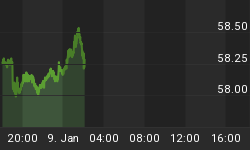The dollar's technical outlook has taken a turn to the worse on a combination of aggressive pre-G7 currency talk favoring yen stability and an 18% increase in oil prices over the past 3 weeks.
Oil Rebound as Fast as Past Decline
An 18% rise over a 3-week period is as significant as a 20% decrease over a 4-week period (oil's decline from mid December to mid January), but oil's rebound has not yet made it to the front pages as it is "only" at 4 week highs, which is not as "spectacular" as 18-month lows - seen in mid January. But the magnitude of the current rebound is comparable to the prior declines. The significance of the recent oil increase is such that US consumers may start to struggle in spending their way to an economic soft landing and keeping intact the Goldilocks scenario (neither too hot nor too cold). A prolonged slowdown in US housing would raise risks of a double whammy for the US economy, especially at a time, when US manufacturing deepens in a recession.
G7 May Trigger Further Yen Moves, but Short-lived
One week ago, it was unthinkable that the official communiqué on foreign exchange markets would address the yen's excessive weakness. But the fact that currency had hit a 21-year low in trade weighted terms, all time lows against the euro and 8 1/ 2 year lows against the British pound, qualifies the yen's weakness to be tabled in the discussions to the extent of triggering notable market moves. Thus, even if the official statement on FX sticks to its usual generic format, along with addressing China's foreign exchange regime (as was done in the last two G7 meetings), there exists the potential for further yen moves (vs Aussie, Euro, Sterling and US dollar) as European officials are capable to raise the volume in their demands for "more FX stability" as has already been demonstrated by German ministers.
Yet, we see the yen's fortunes improving mainly against the Aussie (target 92 by end of week from current 93.28), the euro (154.20 from current 155.95) and British pound (232 from current 236.70 in the event that the Bank of England does not surprise with another rate hike this week). Downside in USDJPY is seen limited to 119.20-25, before consolidating into a lower range inside the 119.00-120.00 range.
Break of 10-year yields/prices, foretells further dollar declines
We warned last week that the price of the 10-year Treasury note (March 2007 contract) was testing higher towards the 107 figure (equivalent of yield testing lower towards 4.81%). We stated that we "expect a breach of the 2-month trend line resistance at 107.17, equivalent to a yield of 4.75" adding that we added that: "Transitioning this analysis into tomorrow's non-farm payrolls, the charts suggest a potentially disappointing report may be in store, which is a negative for the US dollar." Indeed, payrolls were disappointing and the dollar did decline, before ending higher on talk that the ECB will pause for longer than expected.
Finally today, the 10-year T-note broke the 2-month trend line (price broke resistance to 107.18 high, and yield broke support to 4.76%), opening the way for further headway towards the 107.30s until 107.50 resistance, corresponding to a yield of 4.71% from the current 4.77%. This translates into further dollar downside, especially as the oil factor manifested itself into the US dollar index' failure to break above its 200-day moving average for the 4th time in less than one week.

Further USDJPY downside until 119.20s
We expect the continued speculation ahead of the G7 and lack of US economic data as well as rising oil prices to produce a bitter recipe for the dollar/yen, with selling seen extending towards the 119.25 -- 39% retracement of the 114.54-122.18 rise. While the potential for a price reversal exists after the G7 meeting, we are concerned with the onset of further dollar selling ahead of the meeting.

EURUSD apt to break 1.30 to 1.3025-30
Despite the scaling down of the ECB tightening expectations, we expect further upside strengthen towards the 1.30 figure and attain the 8-week trend line resistance at 1.3030, which is also the 38% retracement of the 1.3295-1.2866 decline. Sources for euro upside/dollar downside include oil price escalation and hawkish ECB press conference.

















